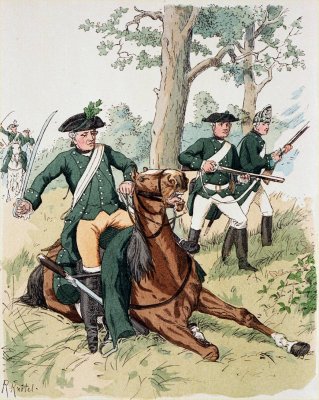Members of a french sniper platoon from the 35th Infantry Regiment during training
© Armée de terre/35RI
Ghillie suit use initially started as a hunting outfit. Entwined in supernatural beliefs, we can trace it's first known appearances to the Paleolithic; the earliest occurence of it's depiction is in the Three brothers cave in southern France.
Millenias later, it is hunters again that birthed it in the way we know it today somewhere during the 19th century, at the heart of the Highlands in Scotland.
Dating back to the Paleolithic, the "sorcerer" is the first painting of a human wearing the pelt and antlers of a deer. Hunting garb or worshiping apparatus, the concept of blending into nature stayed until now
Freytag Jägers wearing the famous green uniform in the Hanover Army in 1760
Illustration from Richard Knötel around 1890
A Union sharpshooter taking aim in a tree during the american civil war
Painting from Homer Winslow in 1863
The advent of military camouflage
While the 7 years war was tearing apart europe, the first units of hunters and gamekeepers are created. They are already proficient at progressing in difficult terrains, have marksman skills and use tracking tactics to follow and harass the enemy. They are the first to wear dark green jackets and uniforms opposed to bright colors that was used to distinguish different units from afar during battles.
Feared for their effectiveness, they are put to use by the british in Northern America and later during the american independance war. Quickly, they are mimicked by their adversaries as well as the armies from the old continent.
Locally erected troops used in the insurrection against the british are made up of seasonned hunters and trappers that surprise regular troops with their guerilla tactics.
It is from the use of these hunters in the military that will appear one of the most iconic title of all, a word that describe in Scotland people that are able to shoot down the elusive "Snipes" bird with their rifle; the "Sniper" is born.
A scottish "Ghillie" in the mid 19th century near Balmoral. Hunters and keepers, they were sadly very rarely photographed
Protection from concealement
The Lovat Scouts will write their own history in the southern mountains of Africa and affirm it later in the muds of europe.
Deployed during the first world war, they are split in multiple units, some are sent to France and the trench nighmare, others land in Gallipoli and the eastern front.
At the beginning of the war, germans started issuing scoped rifles to their troops, the sniper terror started to haunt the opposing side. Seeing the conflict bogging down, starting to hide troop movements and logistic roads from the enemy became a necessity.
Very early, units made up of painter and artists are formed in the french military to camouflage vital interests, on the battle front as well as in the rear. Quickly copied by the other nations, it's rendered mandatory by the coming of aerial photography, the newest intelligence tool.
An exemple of what the camouflage units were managing to produce, the replacement of real trees by fake hollow ones to observe no mans land and ennemy positions
© Imperial War Museum
emerging as we know it today in South Africa at the end of the 19th century, the Ghillie suit takes its roots in antediluvian myths. A real war outfit, it became essential to intelligence gathering as well as neutralization operations.
Under their wing, a true camouflage industry is created, with factories to produce occulting nets.
The Ghillie suit, still mostly hand made, will soon be manufactured on a larger scale.
Camouflage study at the british 1st School of Snipers, you can see what appears to be a 1914 Pattern Enfield sticking out of the leaves on the right
Picture from the book available on gutenberg
An early sniper robe in the center, flanked by mittens and gloves, note the curious patterns that were tried at the time
© Imperial War Museum
A british officer examining the Ghillie suits made by some US soldiers around the end of the war
The second world war become soon enough a playground for snipers. The sheer diversity of theaters allows complete crativity on what can be done with suit making and a lot of very clever camouflages are created everywhere.
Some elite units are issued with camo accessories from the get go, like the infantry squads of the SS totenkopf division on the eastern front. Germans were precursors on a lot of the equipments given to individual soldiers.
Showcasing of different english sniper robes, still hand made
© Imperial War Museum
A SS machine gun team at the Kursk battle, wearing reversible camouflage veils printed in spring and autumn camo
Picture from warthunder, no classified files today
Camouflage is paramount to any special unit as well as snipers. Because of that, Ghillie suits appear on every conflict, everywhere.
From desert sands, to snowy toundras, through Vietnamese jungles, the Ghillie suit transcend time to be used by every military outfit around the world.
An unhappy soviet taken prisonner by the Finns in Karelia, 1941. You can see his very unusual weapon on the back of the finnish NCO on the right, a rarely seen Degtyarev DT-29 usually mounted in tanks (a great thanks to get_tanked for the ID)
Picture from the russian site smolbattle
These units will be part of the elite all along the 18th and 19th centuries.
But it's when we come back to the geographical origin of the "snipers" that we can find the beginning of the Ghillie suit supremacy.
During the last months of 1899, the british crown get involved in a war in nowadays South Africa to annex independant Boer territories of Orange and Transvaal, rich in gold.
Lord Lovat, a scottish aristocrat, use hunters and gamekeepers to raise a unit aimed toward countering the guerilla tactics used by the Boer farmers that terrorize british troops. They use "stalking glasses", sort of telescopes, and curious suits that mimick the vegetation around them, the Ghillie suit.
Ghillies are in fact the name of these employees rich scottish lords use on their lands to track poachers and hunt. The name comes from an old gaelic tale of the "Ghillie Due", sort of male fairy living under tree birch and draped in leaves and branches.
Following the usage becoming wider and wider, the need for automated production grow war after war; akin to the camo patterns hand painted by artists during the first world war becoming factory made soon after with the italians in 1929, first to do so but quickly followed by others.
Taking after camouflage, the Ghillie suits start to be manufactured but retain some hand made features to better blend with the surroundings.
All along the first world war, soldiers completing the first "sniper school" learn to build their suit, often with salvaged and mixed materials.
Camouflages painted by hand are complemented with burlap straps reproducing vegetation, some mittens replaced later by gloves are added to the outfits with hoods cut out of sandbags covering the heads of the marksmen.
Two australian soldiers flanking a turkish sniper, taken prisonner during the Gallipoli battle
The North Vietnamese Army found a cheap but effective way to conceal it's troops, some bamboo rings fastened to the rucksack allows them to add branches and leaves very quickly to their gear. Note the use of a 24/29 MG and a MAS36 rifle, both french weapons seized during the Indochina war
Nowadays widely spread, the Ghillie is used all around the world, in every environment possible and appear in each conflict that arise.
Easily available to purchase, it is today worn by many in the civilian world, as wildlife photographers, hunters and Larpers, to name a few.
A US marine completing the Fort Lejeune pre-scout sniper course of the 2nd marine division
© U.S. Marine Corps/Cpl. Paul S. Martinez
An aussie sniper from the Royal Australian Regiment with a US marine during training in Queensland. Note the commercial type Ghillie hood on the right
© U.S. Marine Corps/Cpl. Cedar Barnes
A recon unit from the chinese People's Liberation Army training in the desert, using QBZ95 rifles
Picture from mod (chinese gov unsecured website)
Two snipers from the ukrainian National Guard blending in the surrounding snow
Coming from an ancestral background, it's future isn't any less bright. The overall concept is here to stay, to conceal the silhouette by breaking the human shape, all while adapting to it's current surrounding to blend in.
Mainly similar to it's (much) older iterations, the Ghillie of the future must exceed upcoming environments and include new technologies as it will be faced by them.
A suit that would not be IR or thermal resistant would be suicidal in today's combat situations, as you can see with a "Phantom of War" suit seen through a FLIR Thermal sight
A different approach to tomorrow's needs, a clever urban Ghillie created by an airsofter
Picture from reddit
This sniper outfit has become an absolute icon, propelled to pop culture fame by films like "Shooter" with Mark Wahlberg from 2007 or the unmissable "All Ghillied Up" mission from Call of Duty Modern Warfare.
However, few people know the origin story of this recognizable piece of equipment that go way back in time.
Trusted companion to special tasks units, fashion accessory and sought after piece of equipment, the Ghillie is surprising by it's history as well as by what's coming.
To go further on this subject, my advice is to read the very detailed book writen by Major H. Hesketh-Prichard titled "Sniping in France" that tell the story of the sniper units evolution during WW1.
His book is available for free online at :
As well as the excellent Guy Hartcup's, "Camouflage, the history of concealment & deception in war"










































